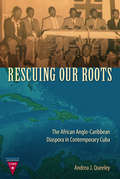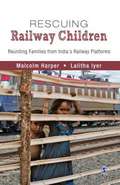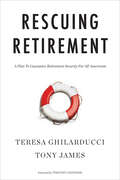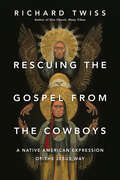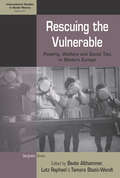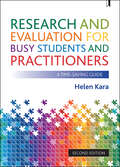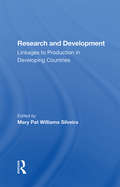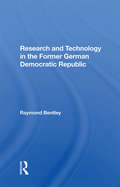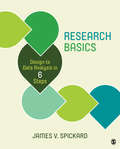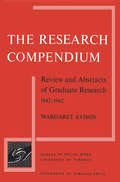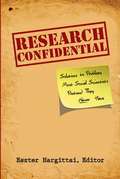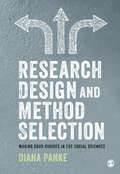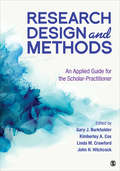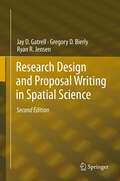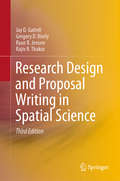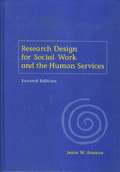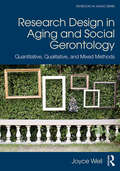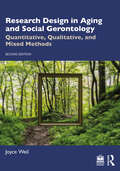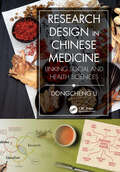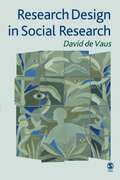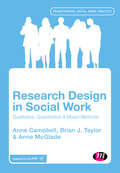- Table View
- List View
Rescuing Our Roots: The African Anglo-Caribbean Diaspora in Contemporary Cuba (Contemporary Cuba)
by Andrea J. Queeley"Contributes new perspectives on historical black identity formation and contemporary activism in Cuba."--Choice "Provides invaluable insight into the histories and lives of Cubans who trace their origins to the Anglo-Caribbean."--Robert Whitney, author of State and Revolution in Cuba: Mass Mobilization and Political Change, 1920-1940 "Adds a missing piece to the existing literature about the renewal of black activism in Cuba, all the while showing the links and fractures between pre- and post-1959 society."--Devyn Spence Benson, Davidson College In the early twentieth century, laborers from the British West Indies immigrated to Cuba, attracted by employment opportunities. The Anglo-Caribbean communities flourished, but after 1959, many of their cultural institutions were dismantled: the revolution dictated that in the name of unity there would be no hyphenated Cubans. This book turns an ethnographic lens on their descendants who--during the Special Period in the 1990s--moved to "rescue their roots" by revitalizing their ethnic associations and reestablishing ties outside the island. Based on Andrea J. Queeley's fieldwork in Santiago and Guantánamo, Rescuing Our Roots looks at local and regional identity formations as well as racial politics in revolutionary Cuba. Queeley argues that, as the island experienced a resurgence in racism due in part to the emergence of the dual economy and the reliance on tourism, Anglo-Caribbean Cubans revitalized their communities and sought transnational connections not just in the hope of material support but also to challenge the association between blackness, inferiority, and immorality. Their desire for social mobility, political engagement, and a better economic situation operated alongside the fight for black respectability. Unlike most studies of black Cubans, which focus on Afro-Cuban religion or popular culture, Queeley's penetrating investigation offers a view of strategies and modes of black belonging that transcend ideological, temporal, and spatial boundaries. A volume in the series Contemporary Cuba, edited by John M. Kirk
Rescuing Railway Children
by Lalitha Iyer Malcolm HarperRescuing Railway Children focuses on runaway children in India who have used trains to take them away from home, and who live on railway station platforms and in trains. It presents the issues and challenges of reaching out to these 'railway children', particularly through the experiences of Sathi, an NGO based in Bangalore. This organisation has chosen to work with children on railway platforms across India with the intention of reuniting them with families wherever possible. The book deals with platform outreach and focuses on shelters close to the stations. The reuniting process is examined from a practical as well as a child-rights perspective. It expands the horizons of analysis by presenting the system prevailing in the UK as a counterpoint, thus highlighting the concerns and current thinking on institutional care and fostering at an international level.
Rescuing Retirement: A Plan to Guarantee Retirement Security for All Americans
by Teresa Ghilarducci Tony JamesRetirement shouldn&’t be just for the rich: &“Finally, a practical plan to address Americans&’ lack of adequate retirement savings.&”—Michael Bloomberg Everyone deserves to be able to retire with dignity, but this core feature of the social contract is in jeopardy. Companies have swerved away from pensions, and most of the workforce has woefully inadequate retirement savings. If we don&’t act to fix this broken system, rates of impoverishment for senior citizens threaten to skyrocket, and tens of millions of Americans reaching retirement age in the coming decades will be forced to delay retirement and will experience a dramatic drop in their standard of living. In Rescuing Retirement, economist Teresa Ghilarducci and billionaire businessman Tony James offer a comprehensive yet simple plan to help workers save for retirement, increase retirement savings by earning higher returns, and guarantee lifelong income for everyone. Built on people&’s own money in individual Guaranteed Retirement Accounts, the plan requires no new taxes, no more bureaucracy, and no increase in the deficit. Speaking to Americans&’ growing anxiety about their ability to retire, Rescuing Retirement provides answers to anyone wanting to understand the growing movement to protect a period of life once considered a deserved time of rest and creativity and offers a practical guide to the future of secure retirement. &“Ghilarducci and James never slip into wonk-speak or jargon, and lay readers will appreciate the way the authors make sense of complex economic issues.&”—Publishers Weekly
Rescuing the Gospel from the Cowboys: A Native American Expression of the Jesus Way
by Richard TwissMissio Alliance Essential Reading List of 2015One of Seedbed's 10 Notable Books from 2015
Rescuing the Vulnerable: Poverty, Welfare and Social Ties in Modern Europe
by Lutz Raphael Beate Althammer Tamara Stazic-WendtIn many ways, the European welfare state constituted a response to the new forms of social fracture and economic turbulence that were born out of industrialization-challenges that were particularly acute for groups whose integration into society seemed the most tenuous. Covering a range of national cases, this volume explores the relationship of weak social ties to poverty and how ideas about this relationship informed welfare policies in the nineteenth and twentieth centuries. By focusing on three representative populations-neglected children, the homeless, and the unemployed-it provides a rich, comparative consideration of the shifting perceptions, representations, and lived experiences of social vulnerability in modern Europe.
Research & Evaluation for Busy Students and Practitioners 2e: A Time-Saving Guide
by Helen KaraResearch doesn't exist in a bubble but co-exists with a multitude of other tasks and commitments, yet there is more need for people to save time than ever before. Brilliantly attuned to the demands placed on researchers, this book considers how students, academics and professionals alike can save time and stress without compromising the quality of their research or its outcomes. Including a new foreword by Patrick Sturgis, Director of UK National Centre for Research Methods, this second edition is fully revised. It provides a new chapter on methodologies covering a range of approaches, and a wealth of updated practical information. Each chapter concludes with annotated further readings and the volume is accompanied by a fully revised and updated companion website. This supportive book is designed for any student or practitioner who wants to know how to do research on top of their main job and still have a life.
Research And Development: Linkages To Production In Developing Countries
by Mary Pat SilveiraWhile many developing countries rapidly expanded their scientific and technological capabilities during the 1960s and 1970s, the current international economic crisis has severely threatened these programs and the developing world has staggered under its debt burden. These economic difficulties highlight the need to utilize effectively the limited scientific and technological resources available. In this volume, an international group of experts explore ways to organize research and development programs; create flexible and appropriate linkages to promote supplier user interactions at national, regional, and international levels; and design policy instruments to encourage and finance research and development.Three case studies illustrate all these aspects of research and development.The contributors also· outline suggestions for pioneer projects in such areas as a technological services delivery system for small industries; a local technology system for rural areas; a fund-syndicating technology delivery system for later enterprises and investors; linkages to improved productivity in under-utilized capacity; and identifications of needs in the least-developed countries.
Research And Technology In The Former German Democratic Republic
by Raymond BentleyThis book discusses the strength of research and technology in the former German Democratic Republic, examining industrial labour productivity and utilising economic and technical indicators to analyse the technological levels of industry in the late 1980s.
Research Basics: Design to Data Analysis in Six Steps
by James V. SpickardResearch Basics: Design to Data Analysis in Six Steps offers a fresh and creative approach to the research process based on author James V. Spickard’s decades of teaching experience. Using an intuitive six-step model, readers learn how to craft a research question and then identify a logical process for answering it. Conversational writing and multi-disciplinary examples illuminate the model’s simplicity and power, effectively connecting the "hows" and "whys" behind social science research. Students using this book will learn how to turn their research questions into results.
Research Basics: Design to Data Analysis in Six Steps
by James V. SpickardResearch Basics: Design to Data Analysis in Six Steps offers a fresh and creative approach to the research process based on author James V. Spickard’s decades of teaching experience. Using an intuitive six-step model, readers learn how to craft a research question and then identify a logical process for answering it. Conversational writing and multi-disciplinary examples illuminate the model’s simplicity and power, effectively connecting the "hows" and "whys" behind social science research. Students using this book will learn how to turn their research questions into results.
Research Compendium: Review and Abstracts of Graduate Research, 1942-1962
by Margaret Avison Florence Strakhovsky Albert RoseThis book represents an important contribution by the School of Social Work at the University of Toronto. It is a record of a carefully designed plan to include a worthwhile research experience in the educational programme of every student engaged in graduate education for the profession. In the introductory essay Dr. Albert Rose explains the methods by which this educational objective has been attempted and traces the evolution of the research requirements as a valid learning experience. The abstracts of 398 student projects provide a varied and interesting illustrative record of the students' work. These are not definitive studies but they are fertile in suggestive ideas; and the reported findings, though limited, are studded with clues for further and more intensive study in a wide range of welfare services and in different forms of social work. The result should be a valuable source of ideas for intending researches in this field both of what is known, and perhaps equally important, of how much is not known. The abstracts have been prepared by Margaret Avison, who has also provided an evocative introductory review.
Research Confidential
by Eszter HargittaiA new guide for a new generation of social science researchers
Research Design & Method Selection: Making Good Choices in the Social Sciences
by Diana PankeHeavily grounded in helping students make the best choices for their projects, this book explores how to develop and work with theory, research questions, and method selection to build solid, logical proposals and move from research concepts to fully realized designs. Rather than rushing initial planning stages or reverse engineering questions from preferred methods, it encourages students to challenge unconscious biases around method selection and analysis and provides step-by-step guidance on choosing a method that is in-line with the question being explored. Focused on the role of the researcher within research design, it stresses the need to consider the theoretical underpinnings of research and not just practical issues when designing a project. It provides a sophisticated toolkit to understand: - The critical issues associated with both qualitative and quantitative methods - The approach that works best for specific research questions - How design choices can affect practice. Perfect for upper undergraduate and postgraduate students, this book will instil confidence and good decision making to ensure constructively informed design and practice.
Research Design & Method Selection: Making Good Choices in the Social Sciences
by Professor Diana PankeHeavily grounded in helping students make the best choices for their projects, this book explores how to develop and work with theory, research questions, and method selection to build solid, logical proposals and move from research concepts to fully realized designs. Rather than rushing initial planning stages or reverse engineering questions from preferred methods, it encourages students to challenge unconscious biases around method selection and analysis and provides step-by-step guidance on choosing a method that is in-line with the question being explored. Focused on the role of the researcher within research design, it stresses the need to consider the theoretical underpinnings of research and not just practical issues when designing a project. It provides a sophisticated toolkit to understand: - The critical issues associated with both qualitative and quantitative methods - The approach that works best for specific research questions - How design choices can affect practice. Perfect for upper undergraduate and postgraduate students, this book will instil confidence and good decision making to ensure constructively informed design and practice.
Research Design and Methods: An Applied Guide for the Scholar-Practitioner (Mixed Methods Research Ser. #2)
by John H. Hitchcock Gary J. Burkholder Kimberley A. Cox Linda M. CrawfordResearch Design and Methods: An Applied Guide for the Scholar-Practitioner is written for students seeking advanced degrees who want to use evidence-based research to support their practice. This practical and accessible text addresses the foundational concepts of research design and methods; provides a more detailed exploration of designs and approaches popular with graduate students in applied disciplines; covers qualitative, quantitative, and mixed-methods designs; discusses ethical considerations and quality in research; and provides guidance on writing a research proposal.
Research Design and Methods: An Applied Guide for the Scholar-Practitioner (Mixed Methods Research Ser. #2)
by John H. Hitchcock Gary J. Burkholder Kimberley A. Cox Linda M. CrawfordResearch Design and Methods: An Applied Guide for the Scholar-Practitioner is written for students seeking advanced degrees who want to use evidence-based research to support their practice. This practical and accessible text addresses the foundational concepts of research design and methods; provides a more detailed exploration of designs and approaches popular with graduate students in applied disciplines; covers qualitative, quantitative, and mixed-methods designs; discusses ethical considerations and quality in research; and provides guidance on writing a research proposal.
Research Design and Proposal Writing in Spatial Science: Second Edition
by Gregory D. Bierly Ryan R. Jensen Jay D. GatrellThe complex interactions between human and physical systems confronting social scientists and policymakers pose unique conceptual, methodological, and practical complications when 'doing research'. Graduate students in a broad range of related fields need to learn how to tackle the discipline-specific issues of space, place, and scale as they propose and perform research in the spatial sciences. This practical textbook and overview blends plenty of concrete examples of spatial research and case studies to familiarize readers with the research process as it demystifies and exemplifies how to really do it. The appendix contains both completed and in-progress proposals for MA and PhD theses and dissertations. Emphasizing research as a learning and experiential process while providing students with the encouragement and skills needed for success in proposal writing, "Research Design and Proposal Writing in Spatial Science" can serve as a textbook for graduate-level research-design courses, as well as for undergraduate-level project-based spatial science courses. Keywords: proposal writing, grant writing, research, geography, spatial science
Research Design and Proposal Writing in Spatial Science: Second Edition
by Gregory D. Bierly Ryan R. Jensen Jay D. Gatrell Rajiv R. ThakurThe investigation of the interactions between human and physical systems poses unique conceptual, methodological, and practical challenges. This book establishes a spatial science framework for policymakers, social scientists, and environmental researchers as they explore and analyze complex problems. The authors provide guidance for scientists, writers, and students across a broad range of fields on how to tackle discipline-specific issues of space, place, and scale as they propose and conduct research in the spatial sciences. This practical textbook and overview blends plenty of concrete examples of spatial research and case studies to familiarize readers with the research process, demystifying and illustrating how it is actually done. The appendix contains both completed and in-progress proposals for MA and PhD theses and dissertations, as well as successful research grants. By emphasizing research as a learning and experiential process, while providing students with the encouragement and skills needed for success in proposal writing, "Research Design and Proposal Writing in Spatial Science" can serve as a textbook for research-design or project-based courses at the upper-division undergraduate and graduate level.
Research Design for Social Work and the Human Services
by Jeane AnastasResearch Design for Social Work and the Human Services integrates a range of research techniques into a single epistemological framework and presents a balanced approach to the teaching of research methods in the "helping professions." Jeane W. Anastas begins with a discussion of the different philosophical perspectives within which social research occurs and continues with problem formulation, research design, and methodological issues influencing data collection, analysis, and dissemination. She presents both fixed (quantitative) and flexible (qualitative) methods of research, granting legitimacy, value, utility, and relevance to both styles of inquiry.Utilizing complete case studies to illustrate different methodological approaches, Research Design for Social Work and the Human Services integrates material on women and people of color, and draws attention to the ways racism, heterosexism, sexism, and classism affect the conceptualization and conduct of research. Anastas not only exposes these biases but actively addresses the experiences, needs, and concerns of clients of both genders and different races, ethnicities, sexual orientations, cultures, and classes.
Research Design in Aging and Social Gerontology: Quantitative, Qualitative, and Mixed Methods (Textbooks in Aging)
by Joyce WeilResearch Design in Aging and Social Gerontology provides a review of methodological approaches and data-collection methods commonly used with older adults in real-life settings. It addresses the role of normative age-related sensory, cognitive, and functional changes, as well as the influence of generational cohort (age-period-cohort) upon each design. It discusses the role of older adults as true co-researchers; issues uniquely related to studies of persons residing in community-based, assisted, skilled, and memory-care settings; and ethical concerns related to cognitive status changes. The text concludes with detailed guidelines for improving existing data collection methods for older persons and selecting the best fitting methodologies for use in planning research on aging. Features of Research Design in Aging and Social Gerontology include: Descriptions and evaluations of a wide range of methodological approaches, and methods used to collect data about older persons (quantitative, qualitative, mixed, and emergent methods: photovoice, virtual environments, etc.) Ways to match research questions to selection of method without a preconceived methodological preference or dominance Real-world and applied examples along with cases from the gerontological literature "How to" sections about reading output/software reports and qualitative-analysis screenshots (from ATLAS.ti) and quantitative (SPSS) output and interpretation Pedagogical tools in every chapter such as text boxes, case studies, definitions of key terms, discussion questions, and references for further reading on chapter topics Glossary of key terms, complete sample research report, and an overview of past methodological research design work in gerontology Companion website at www.routledge.com/cw/Weil where instructors will find PowerPoint presentations, additional discussion questions, and a sample syllabus; and students will find flashcards based on glossary terms, a downloadable copy of the sample research report in the text, and links to data sets, related websites, further reading, and select gerontological journals This text is intended for upper-level undergraduates and masters students in aging and gerontology as well as students in human development, applied anthropology, psychology, public health, sociology, and social-work settings. Health care professionals, social workers, and care managers who work with older adults will also find this text a valuable resource.
Research Design in Aging and Social Gerontology: Quantitative, Qualitative, and Mixed Methods (Textbooks in Aging)
by Joyce WeilThis comprehensive book provides a review across methodological approaches and data-collection methods commonly used with older adults in real-life settings. It addresses the role of normative age-related sensory, cognitive, and functional changes, as well as the influence of generational cohort (age-period-cohort).Fully updated, this second edition reflects recent changes in gerontology and includes more information about equity, diversity and inclusion; the impact of the COVID-19 pandemic; the use of virtual research methods; discussion about the researcher’s reflexivity; the role of theory in research; qualitative research developments; an expansion of secondary analysis of data;and the use of artificial intelligence in research.Features include: Descriptions, evaluations, and applications of a wide range of methodological approaches and methods used to collect data about older persons (quantitative, qualitative, mixed, and emergent methods: photovoice, virtual environments, etc.) Ways to match research questions to selection of method without a preconceived methodological preference or dominance Real-world and applied examples along with cases from the gerontological literature "How to" sections about reading output/software reports and qualitative-analysis screenshots (from NVivo) and quantitative (SPSS) output and interpretation Pedagogical tools in every chapter such as text boxes, case studies, definitions of key terms, discussion questions, and references for further reading on chapter topics Glossary of key terms, complete sample research report, and an overview of past methodological research design work in gerontology This text is intended for upper-level undergraduates and masters students in aging and gerontology as well as students in human development, applied anthropology, psychology, public health, sociology, and social work settings. Healthcare professionals, social workers, and care managers who work with older adults will also find this text a valuable resource.At www.routledge.com/cw/weil instructors will find PowerPoint presentations, additional discussion questions, suggestions for in-class activities and assessments and a sample syllabus; and students will find flashcards based on glossary terms, a downloadable copy of the sample research report in the text, links to data sets, related websites, online videos and podcasts, further reading, select gerontological journals and multiple choice and true or false questions.
Research Design in Chinese Medicine: Linking Social and Health Sciences
by Dongcheng LiResearch Design in Chinese Medicine: Linking Social and Health Sciences is an innovative and comprehensive guide that bridges the ancient wisdom of Traditional Chinese Medicine (TCM) with modern research methods in social and health sciences. Authored by an expert with a background in Chinese medicine and a doctorate in education from Johns Hopkins University, this book is set to revolutionize the way TCM is studied and practiced in the contemporary world.Designed for a diverse readership, from TCM students and practitioners to those in social sciences and holistic medicine, the book provides a unique integration of traditional techniques and modern research approaches. It offers invaluable resources for Doctor of Acupuncture and Herbal Medicine (DAHM) students, helping them deepen and refine their research skills. Additionally, it serves as an essential academic tool for educators in TCM and related fields, perfectly suited for course adoption in over 50 accredited acupuncture schools within the U.S. and extending its reach globally.Research Design in Chinese Medicine: Linking Social and Health Sciences offers a balanced emphasis on both qualitative and quantitative research approaches. This holistic methodology ensures that readers gain a full spectrum of knowledge, from formulating research questions to conducting ethical studies. The step-by-step guide provided in the book is supplemented with a wealth of resources, including a dedicated website, downloadable templates, and case studies, making it not just a book but a complete learning experience.The book is positioned to be a key resource in the field of TCM research. Its interdisciplinary approach and practical guidance make it invaluable to anyone looking to conduct meaningful research in TCM. The combination of the author's expertise and the practical tools offered makes this book a must-have for students, practitioners, and researchers in the field.
Research Design in Social Research
by Professor David de Vaus`With this book David de Vaus has written one of the best general research methods textbooks around. The use of different types of research design as the point of departure is a different and very helpful approach to take, especially since many textbooks confuse issues of method and design. The author outlines with great clarity a wide variety of issues, including testing theories, causation, data analysis, and the main considerations involved in using the different research designs covered. Both students and their instructors will find this an extremely valuable, well-written book' - Professor Alan Bryman, University of Loughborough `A wonderful opportunity for research design students and practitioners to think more about the planning and process of research design' - Forum for Qualitative Social Research This book is intended to show social science students the importance of attending to design issues when undertaking social research. One of the main problems in doing practical research is that design and structure are inappropriate for the uses of research. They often do not support the conclusions that are drawn from it. Several research methods books focus on data collection strategy and statistical analysis. While these issues are pertinent, this book argues that the core of research methods is the structure and design of the research. The book: - provides students with a clear understanding of the importance of research design and its place in the research process. - describes the main types of research designs in social research. - explains the logic and purposes of design to enable students to evaluate particular research strategies - equips students with the design skills to operate in real world research situations The book is divided into five parts. Part One explores issues about types of research, research concepts, research questions, causality and basic issues in the design process. The remaining four parts focus on different types of research design. Experimental, longitudinal, cross-sectional and case-study methods are clearly and systematically examined, and their strengths and weaknesses are described. The result is a one-stop critical guide to design in social research that students and researchers will find invaluable.
Research Design in Social Research
by Professor David de Vaus`With this book David de Vaus has written one of the best general research methods textbooks around. The use of different types of research design as the point of departure is a different and very helpful approach to take, especially since many textbooks confuse issues of method and design. The author outlines with great clarity a wide variety of issues, including testing theories, causation, data analysis, and the main considerations involved in using the different research designs covered. Both students and their instructors will find this an extremely valuable, well-written book' - Professor Alan Bryman, University of Loughborough `A wonderful opportunity for research design students and practitioners to think more about the planning and process of research design' - Forum for Qualitative Social Research This book is intended to show social science students the importance of attending to design issues when undertaking social research. One of the main problems in doing practical research is that design and structure are inappropriate for the uses of research. They often do not support the conclusions that are drawn from it. Several research methods books focus on data collection strategy and statistical analysis. While these issues are pertinent, this book argues that the core of research methods is the structure and design of the research. The book: - provides students with a clear understanding of the importance of research design and its place in the research process. - describes the main types of research designs in social research. - explains the logic and purposes of design to enable students to evaluate particular research strategies - equips students with the design skills to operate in real world research situations The book is divided into five parts. Part One explores issues about types of research, research concepts, research questions, causality and basic issues in the design process. The remaining four parts focus on different types of research design. Experimental, longitudinal, cross-sectional and case-study methods are clearly and systematically examined, and their strengths and weaknesses are described. The result is a one-stop critical guide to design in social research that students and researchers will find invaluable.
Research Design in Social Work: Qualitative and Quantitative Methods (Transforming Social Work Practice Series)
by Anne Campbell Brian J. Taylor Ms Anne McGladeSocial work research often focuses on qualitative designs and many students believe that the quantitative research pathway is either too complicated or is beyond their grasp. This book outlines how social work students can undertake a research project from either a qualitative, quantitative or mixed methodological approach. The authors introduce key concepts in an accessible and structured manner and go on to demonstrate each of the approaches from inception of research idea, to realisation of methodological approach, to research process, to data analysis and conclusion. More than just another research text, this book remains grounded in social work practice and has clear links to the Professional Capabilities Framework for Social Work.
